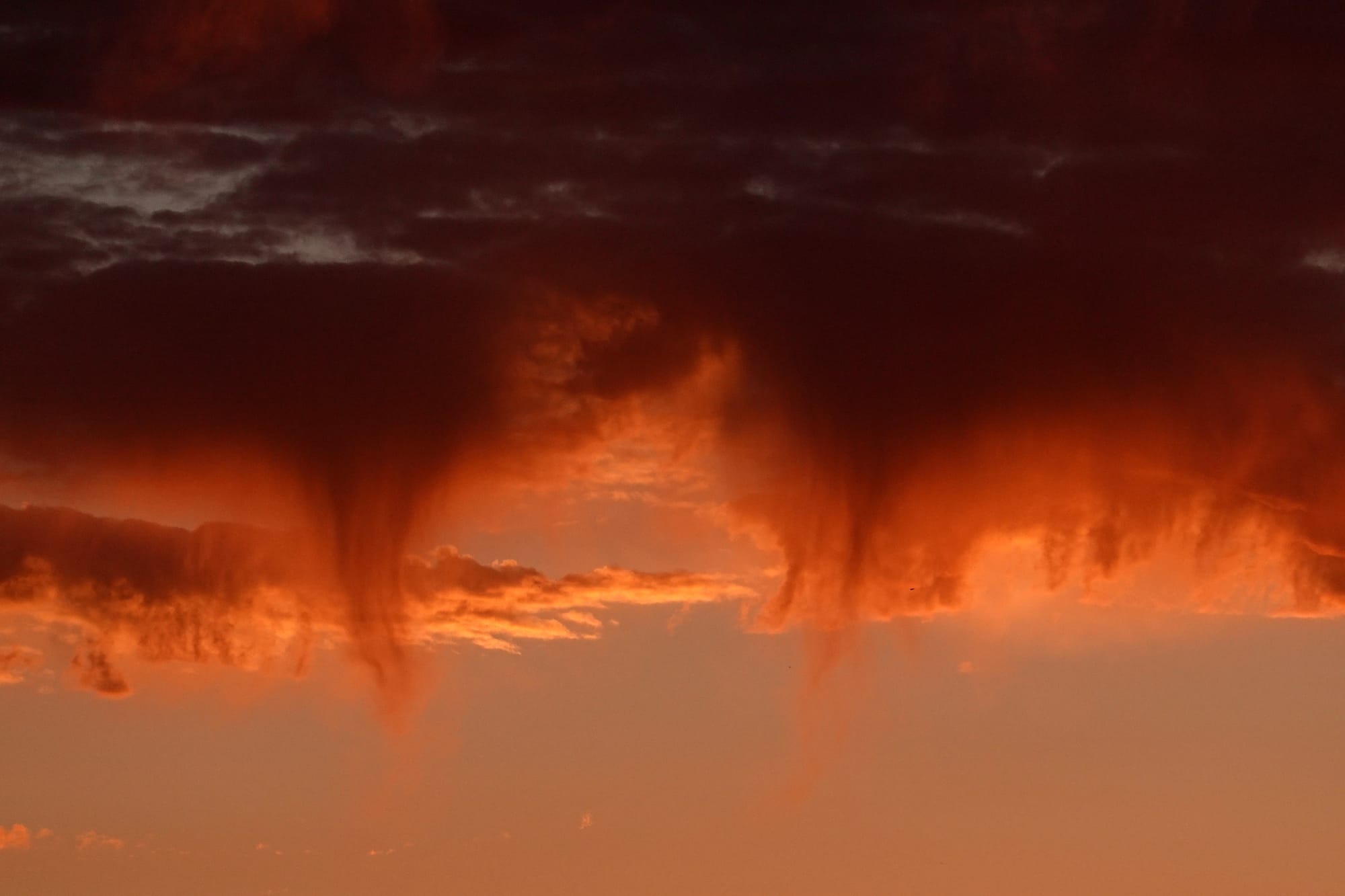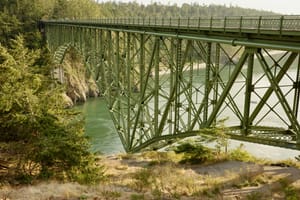One funny thing about calling yourself a writer is that you can take a vacation — fly across the country with your family, bouncing between relatives' houses, your whole routine upended, two weeks of fresh sensory experiences — and yet the whole time you're doing things that resemble your work, which is to say that you're thinking through ideas and coming up with interesting words to put them into. I recently took such a vacation, and I found myself spending hours thinking about commercial logging operations, and how I might casually mention that after ten years without maintenance, a gravel forestry road can no longer be driven on. I can't really call this work, I think, because I didn't write it down at the time, but it certainly felt like labor, and it occurs to me now that maybe I missed the point of going on vacation. Or perhaps I've just found a profession which rewards me for what I'm already inclined to do: Think for hours about something I've seen, try to fit it into the rest of what I know, and work back and forth over its description until it feels like a part of me.
Anyway, I'm glad to be back. And, here are some things that feel like they're part of me now.
SCOPE CREEP.
- There are a lot of kinds of wine. I can’t name many of them — I’m either unwilling or unable to commit much of my mind to oenology — but I know that when I was a kid they seemed to mostly be red or white. Red wine is made by mashing up whole, red grapes and fermenting them. White wine is made by taking the skins off of either red or white grapes, and fermenting just their insides. There’s also orange wine, which is made not from oranges but from whole white grapes, skins and all. Orange wines were fairly obscure until a few years ago; they are, nevertheless, “standard” wines in the sense that they’re made from crushed, fermented fruit which is fermented with “malo-lactic bacteria, yeast or yeast cultures grown in juice of the same kind of fruit.”
But there are other kinds of wines! They are in the legal sense not standard, and if it were up to me I’d probably call them nonstandard wines, but apparently the Bureau of Alcohol, Tobacco, Firearms and Explosives refers to them as other than standard, a phrase which is sometimes abbreviated as “OTS.” Some OTS wines are not intended for drinking at all; these might end up as vinegar, or they might have salt added to them so that they can be used for cooking and not be taxed for their alcohol content. But then there’s "OTS orange wine," which is made from actual orange peels and fermented up to a whopping 21% ABV without changing its tax classification (wine is taxed at a lower rate than distilled spirits). OTS orange wine is filtered to create what bottled, canned, and Tetra Pak’d cocktail entrepreneurs might call “a neutral base, a clean base,” and then mixed with various flavorings, sweeteners, and artificial colors to create what the industry refers to as ready-to-drink or “RTD” cocktails.
Related: Today, distilled spirits sometimes list not their alcohol content but their “proof,” an antiquated term which, today, is equivalent to double their alcohol content. This is an accident of history and low precision metrology: In the seventeenth century, distilleries would “prove” their alcohol content by splashing a little booze onto some gunpowder and throwing a match on it. If it burned, it was considered “100% proof,” even though that corresponded with an alcohol content in the neighborhood of (but not precisely) 50%. - A short blog post analyzing how July’s CrowdStrike outage affected various airlines’ flight schedules, both in raw numbers and as a percentage of the baseline.
- I spent part of August in the Olympic National Forest, and in privately-owned forests and tree farms adjacent to it. It’s an odd phrase to me, “tree farm,” and I find “working forest” similarly strange, but I suppose the reality is that while soybeans and wheat grow reasonably well (with caveats) in a high-touch monocultural environment, the life cycles of spruce and pine and fir are more amenable to hands-off management in a diverse and sprawling landscape. The working forests I was in were last harvested about eighty years ago; some were planted from seedlings and others had been populated by volunteers. It’s a crazy business model: You take a complex and delicate ecosystem, clear-cut it once or twice a century, and hope that it grows back in a way that your grandchildren’s generation can clear-cut again for a profit.
And in the meantime, a lot of people who are not your grandchildren worry about the way you’re managing the forest ecosystem, and how that affects the (mostly) characteristic megafauna that they care about. Enter the Olympic Experimental State Forest, which covers about a thousand square kilometers and is managed by Washington State’s Department of Natural Resources. From their website:
The Olympic Experimental State Forest (OESF) was designated in 1992 to test and learn from an innovative management approach to meeting revenue and ecological objectives. This approach is called “integrated management.” Rather than divide the OESF into a working forest and a nature preserve, the Washington State Department of Natural Resources (DNR) manages the OESF as an integrated whole, with timber harvests interspersed with sensitive areas that are managed lightly or not at all. The goal is to create a mosaic of forest ages ranging from newly planted to old growth…
In the OESF, the primary harvest techniques are thinning and stand replacement harvest. In thinning, trees are removed in an irregular pattern, some gaps are introduced into the forest canopy to encourage development of an understory of young trees and shrubs, and other areas are left as they are to provide additional variation in forest stand structure. This technique is called "variable density thinning."
For stand replacement, DNR uses a technique called “variable retention harvest". With this technique, DNR retains at least eight standing, large, and small trees per acre that represent the pre-harvest stand. Snags are also retained when it is safe to do so. DNR also retains habitat for threatened and endangered species and forest in sensitive areas such as potentially unstable slopes, wetlands, and stream banks. The result is an irregularly shaped harvest opening. This technique is different than clear-cutting, in which all trees are removed.

- A gas’s pressure, multiplied by its volume, is equal to the amount of gas (in moles), times the ideal gas constant R, times temperature. This is the ideal gas law, and it describes how gasses act as they are heated, cooled, condensed, and expanded.
One interesting effect of the ideal gas law is that if you started in a cloud and headed down towards earth, you might find that as pressure increased, temperature would also increase. This can produce funny effects, like virga or dry storms. These occur when precipitation forms at high altitudes as ice crystals or rain; it then begins to fall, and is heated as pressure increases; it then evaporates back into a gas before reaching the ground. Virga can make clouds look like cartoon speech bubbles, their leaders becoming pointy and then disappearing as they reach towards earth. - Simone Giertz grapples with her early YouTube fame and the difficulties she’s had transitioning from engineering sideshow act to a legit product business.
- An interesting op-ed on the poor state of the American elevator industry: “With around one million of them, the United States is tied for total installed devices with Italy and Spain. (Spain has one-seventh our population, 6 percent of our gross domestic product and fewer than half as many apartments.) Switzerland and New York City have roughly the same population, but the lower-rise alpine country has three times as many single-family houses as Gotham — and twice as many passenger elevators…A basic four-stop elevator costs about $158,000 in New York City, compared with about $36,000 in Switzerland."
Read the full story
The rest of this post is for paid members only. Sign up now to read the full post — and all of Scope of Work’s other paid posts.
Sign up now

